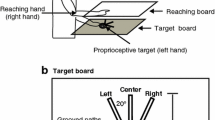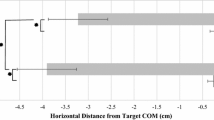Abstract
The impact of reaching experience on the ability to predict one’s own reaching range was investigated. Left- and right-handed participants made verbal estimates about the reachability of a target object for both arms in ipsilateral and contralateral frontal space. There was a significant overestimation bias in both groups and for both hands. The overestimation bias increased with the target object’s eccentricity in contralateral space. The implications of these findings for models of motor control and motor imagery are discussed.


Similar content being viewed by others
References
Annett M (1970) A classification of hand preference by association analysis. Br J Psychol 61:303–321
Bizzi E, Hogan N, Mussa-Ivaldi FA, Giszter S (1992) Does the nervous system use equilibrium-point control to guide single and multiple joint movements? Behav Brain Sci 15:603–613
Bootsma RJ, Bakker FC, van Snippenberg F, Tdlohreg CW (1992) The effect of anxiety on perceiving the reachability of passing objects. Ecol Psychol 4:1–16
Bryden MP, Singh M, Steenhuis RE, Clarkson KL (1994) A behavioral measure of hand preference as opposed to hand skill. Neuropsychologia 32:991–999
Carello C, Grosofsky A, Reichel FD, Solomon HY, Turvey MT (1989) Visually perceiving what is reachable. Ecol Psychol 1:27–54
Decety J, Jeannerod M (1996) Mentally simulated movements in virtual reality: Behav Brain Res 72:127–134
di Pellegrino G, Frassinetti F (2000) Direct evidence from parietal extinction of enhancement of visual attention near a visible hand. Curr Biol 10:1475–1477
Fischer MH (2000) Estimating reachability: whole body engagement or postural stability? Hum Mov Sci 19:297–318
Fischer MH (2003) Can we correctly perceive the reaching range of others? Br J Psychol 94:487–500
Fischer MH, Rosenbaum DA, Vaughan J (1997) Speed and sequential effects in reaching. J Exp Psychol Hum Percep Perform 23:404–428
Fischer MH, Stewart C, Wood AR (2004) Does motor imagery depend on movement skills? In: Y. Coello (ed) Fonctionnement et dysfonctionnement perceptif et moteur. Presse Universitaires du Septentrion, Lille (in press)
Fisk JD, Goodale MA (1985) The organization of eye and limb movements during unrestricted reaching to targets in contralateral and ipsilateral visual space. Exp Brain Res 60:159–178
Fitts PM (1954) The information capacity of the human motor system in controlling the amplitude of movement. J Exp Psychol 47:381–391. Reprinted 1992 in: J Exp Psychol Gen 121:262–269
Gerardin E, Sirigu A, Lehericy S, Pauline J-B, Gaymard B, Marsault C, Agid Y, Le Bihan D (2000) Partially overlapping neural network for real and imagined hand movements. Cereb Cortex 10:1093–1104
Goodale MA, Milner AD (2004) Sights unseen. Oxford University Press, Oxford
Graziano MSA, Gross CG (1998) Spatial maps for the control of movement. Curr Opin Neurobiol 8:195–201
Graziano MSA, Yap GS, Gross CG (1994) Coding of visual space by premotor neurons. Science 266:1054–1057
Jeannerod M (1988) The neural and behavioural organization of goal-directed movements. Clarendon Press, Oxford
Jeannerod M (1997) The cognitive neuroscience of action. Blackwell, Cambridge MA
Johnson SH (2000) Thinking ahead: The case for motor imagery in prospective judgments of prehension. Cognition 74:33–70
Keogh J, Sugden D (1985) Movement skill development. Macmillan, New York
Li C-SR (2000) Impairment of motor imagery in putamen lesions in humans. Neurosci Lett 287:13–16
Lorch RF, Myers JL (1990) Regression analyses of repeated measures data in cognition research. J Exp Psychol Learni Mem Cogni 16:149–157
Mark LS, Nemeth K, Gardner D, Dainoff MJ, Paasche J, Duffy M, Grandt K (1997) Postural dynamics and the preferred critical boundary for visually guided reaching. J Exp Psychol Hum Percep Perform 23:1365–1379
Maruff P, Velakoulis D (2000) The voluntary control of motor imagery. Imagined movements in individuals with feigned motor impairment and conversion disorder. Neuropsychologia 9:1251–1260
Maruff P, Wilson PH, De Fazio J, Cerritelli B, Hedt A, Currie J (1999) Asymmetries between dominant and non-dominant hands in real and imagined motor task performance. Neuropsychologia 37:379–384
Milner AD, Goodale MA (1995) The visual brain in action. Oxford University Press, Oxford
Palmer SE (1999) Vision science: photons to phenomenology. MIT Press, Cambridge MA
Parsons LM (1994) Temporal and kinematic properties of motor behavior reflected in mentally simulated action. J Exp Psychol Hum Percep Perform 20:709–730
Rizzolatti G, Luppino G (2001) The cortical motor system. Neuron 31:889–901
Robinovitch SN (1998) Perception of postural limits during reaching. J Mot Behav 30:352–358
Rochat P, Wraga M (1997) An account of the systematic error in judging what is reachable. J Exp Psychol Hum Percep Perform 23:199–212
Rosenbaum DA, Loukopoulos LD, Meulenbroek RGJ, Vaughan J, Engelbrecht SE (1995) Planning reaches by evaluating stored postures. Psychol Rev 102:28–67
Rosenbaum DA, Meulenbroek RG, Vaughan J, Jansen C (2001) Posture-based motion planning: applications to grasping. Psychol Rev 108:709–734
Sirigu A, Duhamel JR (2001) Motor and visual imagery as two complementary but neurally dissociable mental processes. J Cogn Neurosci 13:910–919
Stins JF, Kadar EE, Costall A (2001) A kinematic analysis of hand selection in a reaching task. Laterality 6:347–367
Viguier A, Clement G, Trotter Y (2001) Distance perception within near visual space. Perception 30:115–124
Acknowledgements
I thank Birgitt Aßfalg for data collection and John Stins for discussions about this work, as well as an anonymous reviewer for helpful comments. This work was sponsored by the Royal Society (RSRG 21632).
Author information
Authors and Affiliations
Corresponding author
Rights and permissions
About this article
Cite this article
Fischer, M.H. Perceived reachability: the roles of handedness and hemifield. Exp Brain Res 160, 283–289 (2005). https://doi.org/10.1007/s00221-004-2007-x
Received:
Accepted:
Published:
Issue Date:
DOI: https://doi.org/10.1007/s00221-004-2007-x




